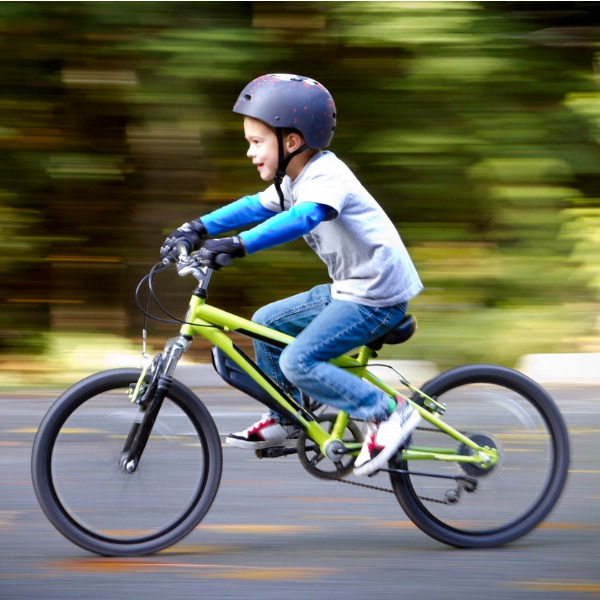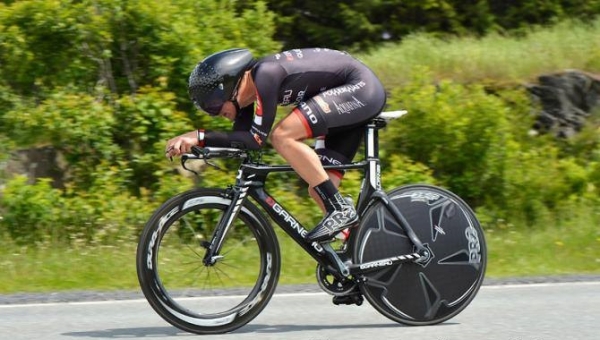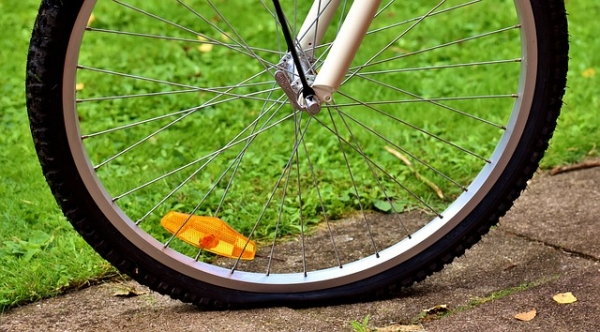How Can I Go Faster on My Bike?

Boy on bicycle (VisualCommunications, iStockphoto)

Boy on bicycle (VisualCommunications, iStockphoto)
How does this align with my curriculum?
| Grade | Course | Topic |
|---|
You don’t have to pedal harder to go faster. You just have to understand a little bit about gravity, drag and friction!
Do you or does someone you know ride a bike? Your answer is probably yes. Today, people around the world use bikes every day for different reasons. Some people ride bikes for transportation. Some people ride bikes for exercise. Some people ride bikes just for fun!
Did you know?
The first bicycle was invented in 1817.

Did you know?
Today, people have to take driving lessons before they can drive a car. In the past, people had to take special bike-riding classes.
If you’re riding your bike for fun, you might not care how fast you’re going. But what if you were late for school? I bet you’d want to go fast then!
Picture yourself trying to go faster on your bicycle. What comes to mind? Many people imagine pedalling harder. Would you believe me if I told you that there are other ways to increase your speed? Well, there are!
Let’s look at some of the forces that pull and push a moving bicycle. And then, let’s look at some ways that you can decrease the magnitude (size) of these forces so that you can go faster.
The pull of gravity
Why is it harder to cycle up a hill than on flat ground? If you said gravity, you’re right! Gravity is a type of force created by a large object like a planet or a star. The gravity from a planet, like Earth, pulls other objects towards itself. This is what keeps us from floating into space!
Has anyone ever asked you how much you weigh? Your weight is not the same thing as your mass. An object’s weight is the measure of gravity acting on it. But an object’s mass is a measure of the number of atoms in it.
Mass is measured in kilograms (kg). Your weight is actually your mass multiplied by the force of gravity. The formula for this is 9.8 Newtons per kilogram (9.8 N/kg). When someone asks, “How much do you weigh?” most of us answer in kilograms. But technically, we should be answering in Newtons!
As the mass of an object increases, so does the force of gravity acting on it. More mass means more weight. So how can you decrease the force of gravity pulling on your bike? Lower its mass! Carry less in your backpack. Or, try riding a lighter bike.
Did you know?
Carbon fibre is one of the lightest materials used to make bike frames. A carbon fibre bike can weigh less than 6.8 kg (15 lbs.). That’s about the same weight as a small dog like a Toy Spaniel!
The push of air
Don’t you just hate it when you have to pedal into the wind? When you are biking, the air can seriously slow you down! That is because air is not just empty space. It is made up of molecules of gas. You have to push these air molecules aside so that you can move forward. It’s kind of like when a football player pushes players from the other team out of the way to get to the goal line.
The force that the air exerts is called air resistance or drag. That’s because it works against the forward motion of an object through air.
Air resistance is most noticeable when you are travelling quickly. You might not notice it when you are walking. But have you ever held your arm out the window of a moving car? If so, you have probably felt air resistance.
To go faster on a bike, you can try to become more aerodynamic.You can do this by reducing air resistance or drag. For example, get your upper body down closer to your bike. That way, fewer air particles need to be pushed aside as you move forward.
Have you ever seen cyclists in races hunched down low over their handlebars? They do this to reduce drag. This is also why professional racing cyclists wear helmets that are sleek and tapered backwards.

The Grip of Friction
Have you ever had to slide a heavy object, like a desk, across the carpet? It’s not that easy to do, is it? This is because there are forces that attract the molecules in the desk to the molecules in the floor. Before you can move the desk, you have to overcome these forces. We call this type of resistance sliding friction. Sliding friction is what makes your running shoes grip the gym floor!
But what if you added wheels to the bottom of that desk? Moving it would be much easier. That’s because wheels don’t have to overcome sliding friction. But there is a different, smaller force that wheels do have to overcome. It’s called rolling friction or rolling resistance.
Want to see how rolling resistance slows you down? Watch the tires of other people’s bikes as they ride. If you look closely, you may see that the tires look a bit flat. This is because the force of gravity on you and your bike pushes down on the tires. The tires are full of air.

What happens when gravity pushes down on you and your bike? The tires bulge outwards. This causes more of the tire to touch the road. This makes the tire grip more. It’s just like the desk on the carpet.
How can you decrease rolling resistance? Pump your tires with more air! More air in the tires makes them firmer. This way, they won’t flatten as much, so less of the tire will touch the ground. For example, road racing bikes are made to go fast, so they typically have a lot of air in their tires.
The less your tires flatten, the less rolling resistance you will face, and the faster you'll go!
To sum up...
Learning about forces is just like riding a bike. Once you get the hang of it, it’s easy! So the next time you’re racing to beat the bell at school, try these tips and tricks from the world of science. First, take a minute to empty your backpack of anything heavy. Then, pump up your tires. Finally, while you are riding, crouch down low over your handlebars.
And here is one last tip: have fun!
Starting Points
- What things do you do when riding a bike to make yourself go faster?
- Where or when have you experienced air resistance?
- What activities have you done that involve sliding or rolling friction in some way?
- How can an understanding of the forces acting on a bicycle (science) help people to design better bicycles (technology)?
- What is the difference between mass and weight?
- What is the difference between sliding friction and rolling friction?
- Draw a picture of a bicycle in motion and identify the forces mentioned in the article that are acting on the bike. Use arrows to indicate which direction each force is acting.
- What does aerodynamic mean? How is this related to air resistance?
- How are newly designed vehicles tested for safety? Why is this step part of the Technological Problem Solving process (or the Design & Build process)?
- Have you heard about carbon fibre bicycles before? Where have you heard about them? What features and/or benefits of carbon fibre were discussed or described?
- This article can be used for grades 6-8 math and physics for teaching and learning related to forces on objects, gravity and aerodynamics. Concepts introduced include forces, magnitude, gravity, weight, mass, Newtons, air resistance, drag, rolling resistance and sliding friction.
- After reading the article and viewing the embedded video, teachers could have students complete a Concept Definition Web Learning strategy for one of the key concepts introduced in the reading, such as friction or air resistance. Ready-to-use Concept Definition Web reproducibles are available to download in [Google doc] and [PDF] formats.
- Teachers could also have students compare and contrast rolling friction with sliding friction, using a Venn diagram learning strategy.
- For a mathematics skills connection, teachers could have students calculate their weight in Newtons on the moon, low Earth orbit (as on the ISS) and on different planets in the Solar System. Students could be provided with the acceleration due to gravity measurements for each solar body or students could conduct research to find these measurements and then make the weight calculations. For example:
- Acceleration due to gravity:
- On the ISS or in Low Earth Orbit (LEO) = 9 m/s2
- Surface of the Moon = 1.625 m/s2
- Surface of Mars = 3.711m/s2
- Acceleration due to gravity:
Connecting and Relating
- What things do you do when riding a bike to make yourself go faster?
- Where or when have you experienced air resistance?
- What activities have you done that involve sliding or rolling friction in some way?
Relating Science and Technology to Society and the Environment
- How can an understanding of the forces acting on a bicycle (science) help people to design better bicycles (technology)?
Exploring Concepts
- What is the difference between mass and weight?
- What is the difference between sliding friction and rolling friction?
- Draw a picture of a bicycle in motion and identify the forces mentioned in the article that are acting on the bike. Use arrows to indicate which direction each force is acting.
- What does aerodynamic mean? How is this related to air resistance?
Nature of Science/Nature of Technology
- How are newly designed vehicles tested for safety? Why is this step part of the Technological Problem Solving process (or the Design & Build process)?
Media Literacy
- Have you heard about carbon fibre bicycles before? Where have you heard about them? What features and/or benefits of carbon fibre were discussed or described?
Teaching Suggestions
- This article can be used for grades 6-8 math and physics for teaching and learning related to forces on objects, gravity and aerodynamics. Concepts introduced include forces, magnitude, gravity, weight, mass, Newtons, air resistance, drag, rolling resistance and sliding friction.
- After reading the article and viewing the embedded video, teachers could have students complete a Concept Definition Web Learning strategy for one of the key concepts introduced in the reading, such as friction or air resistance. Ready-to-use Concept Definition Web reproducibles are available to download in [Google doc] and [PDF] formats.
- Teachers could also have students compare and contrast rolling friction with sliding friction, using a Venn diagram learning strategy.
- For a mathematics skills connection, teachers could have students calculate their weight in Newtons on the moon, low Earth orbit (as on the ISS) and on different planets in the Solar System. Students could be provided with the acceleration due to gravity measurements for each solar body or students could conduct research to find these measurements and then make the weight calculations. For example:
- Acceleration due to gravity:
- On the ISS or in Low Earth Orbit (LEO) = 9 m/s2
- Surface of the Moon = 1.625 m/s2
- Surface of Mars = 3.711m/s2
- Acceleration due to gravity:
Learn more
How to cycle faster for free - Ride your bike faster with less effort (2013)
Video (3:22 min.) from the Global Cycling Network giving tips and tricks on how to go faster, and save effort.
Bicycle science (2017)
Article from ExplainThatStuff that explains the science behind bicycles.
Friction (2016)
Video (10:58 min.) from Crash Course Physics about two different kinds of friction, how they work, and how they're different.
References
Brett, M. (2018, December 4). 6 of the lightest road bikes — bike makers challenge the scales with exotic materials. road.cc.
Canada 2067. (2017, May 12). Science of cycling.
Connolly, J. (2016). Understanding the magic of the bicycle. Morgan & Claypool Publishers.
Gross, A., Kyle, C., & Malewicki, D. (1983). The aerodynamics of human-powered land vehicles. Scientific American, 249(6), 142-152. DOI: 10.1038/scientificamerican1283-142
Penn, R. (2011). It's all about the bike: The pursuit of happiness on two wheels. Penguin Books Ltd.
Persson, B. (2013). Sliding friction (2nd ed.). Springer, Berlin.